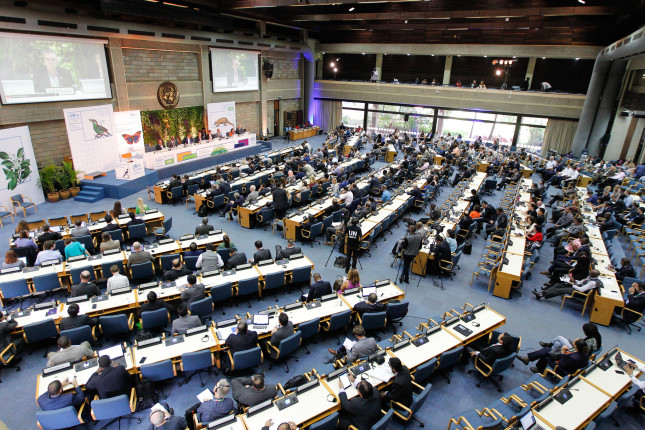-
From Resolution to Solution: UNEA’s Unique Opportunity to Tackle Environmental Dimensions of Armed Conflicts
March 8, 2019 By Wim Zwijnenburg
When the Fourth Session of the UN Environment Assembly (UNEA-4) takes place in Nairobi starting March 11, governments, international organizations, and civil society organizations will discuss issues on the theme of innovative solutions for environmental challenges and sustainable consumption and production with over 30 draft resolutions submitted for discussion. With few international forums where the environmental dimensions of conflict can be properly discussed, we were optimistic about the past resolutions tackling this topic.
After the promising resolution to deal with conflict pollution at the third UNEA meeting in 2017, expectations were high that environmental damage, as it unfolded in countries like Iraq and the Ukraine, could once more gain priority on the political agenda. Various civil society organizations, including PAX, made recommendations on implementation and opportunities. However, will these resolutions make a real difference or turn out to be paper tigers?
Looking Back
What could be done to put teeth in the UN Environment Assembly’s paper tiger resolutions? To understand their potential, let’s take a look at UNEA resolution 3/1 on conflict-pollution. It grew out of the need to tackle the devastating destruction, including burning oil wells and polluted water sources brought upon Iraq in the war against the so-called Islamic State. The resolution provided sufficient impetus for some states to put their money where their mouths are and support affected countries and UN Environment in its work. The report on the implementation of UNEA 3, provides an impressive list of programs undertaken. UN Environment Programme’s support of the Iraqi government has been a helpful start in identifying areas of concern, and in kickstarting training for relevant ministries on assessment of oil contaminated sites.
But despite the projects implemented, missed opportunities need to be addressed. First, the voices of afflicted communities have so far been missing, notably in planning and strategy assessments, even though this was called for in UNEA 3/1. As reported in 2018, civilians in contaminated areas did not get the help they needed, even though, again, environmental concerns were high on the agenda of local communities, according to focus group studies. Access to agricultural land and use of water sources are crucial for livelihoods in areas where farming and livestock are main sources of income. Because funding was limited, those implementing the resolution focused only on technical work, thus missing out on input from the affected communities
Yet environmental degradation, health concerns, and political tensions once more made headlines last summer, as more than 100,000 people in Basra got sick from polluted water and thousands more protested poor environmental governance. One of their grievances was that their voices weren’t being heard or incorporated into government policies.
Lack of Follow-Up
Second, countries that had most strongly supported the resolutions, including many European ones, have not actually funded them. When PAX reached out to government officials after UNEA-3 to gauge interest in what could be done to implement the resolution, we were referred to embassies in affected countries for support, a tacit suggestion that actually implementing the resolution wasn’t a priority for the very same governments that had pushed for it. This signals another worrisome development whereby governments seek their moment in the sun at negotiations, yet fail to follow-up, either by supporting implementation through funding or by incorporating the agreed resolutions into their development or support programs in affected countries.
Lastly, the UNEA 3/1 resolution could have been an effective vehicle to drive the wider debate on conflict-environment issues to a higher level. Ongoing hot conflicts such as Syria, Yemen, and eastern Ukraine continue to leave a trail of environmental damage and health risks that have yet to be properly addressed. The most meaningful discussions to date were at the International Law Commission’s debate on its draft principles on protection of the environment in armed conflict and at a UN Security Council Arria-formula meeting. UNEA-4 ought to be another opportunity for states to highlight these concerns, but, as noted by the Conflict & Environment Observatory’s latest analysis, hardly any references to conflict and environment can be found in this year’s resolution texts.
Commitment and Action Needed
What lessons can we learn from all this and what can be done better to address the conflict-environment angle? Ownership would help. States putting their weight behind a resolution should commit them, both in word and deed. In practice, this means funding support programs, either through affected governments, international organizations, or the relevant civil society groups that are addressing the issues at the core of the resolution. The hard work done by diplomats and civil society at the negotiations should not be in vain and must lead to changes on the ground. Conflict-affected states and those working with these states through their program work are in unique positions to highlight ongoing concerns.
The next issue is transparency and accountability. Having a reporting mechanism at follow-up UNEAs would allow us to better monitor progress made in implementing resolutions. Such an endeavor would help identify successes in tackling the environmental dimensions of conflict, provide an overview of what remains to be done, and would also work as an incentive to push for more investment in identification, monitoring, assessment and rehabilitation work. In addition, civil society groups could provide their own annual overview of conflict-environment issues and the work done in various countries on this topic. The net effect would be more insight into implemented projects and more oversight of the process from UNEA on down. And finally, we need more critical reflection as stakeholders learn about the Environment Assembly’s process: What’s worked well and where are improvements on implementation and participation needed?
Recommendations
With this year’s focus on innovative solutions, there should be ample space to highlight the specific environmental angles of armed conflict (for example, identifying and tracking environmental damage through crowd- and open-source technologies and application of citizen science). These tools could help us get better information and a faster response to environmental damage and pollution concerns during or after armed conflicts.
And on a policy level, we appear to have missed the opportunity, on this occasion at least, to include innovative policies on the conflict-environment nexus agenda that would help rapidly identify and minimize environmental damage, such as that related to deforestation, waste management, and chemical pollution concerns, and build better responses and incorporate environmental policies in response and reconstruction work.
But with so many other pressing concerns around climate change, and so many states pursuing their own priorities, including a strong focus on environmental dimensions of armed conflict will be a difficult endeavor. With the upcoming meeting, we have a unique opportunity to make meaningful change on a range of environmental issues that can determine the future of our planet.
Wim Zwijnenburg is a Project Leader at PAX, a Dutch NGO working on peace-building and humanitarian disarmament and runs the Conflict and Environment project.
Thanks to Pete Schwartzstein for additional editing work.
Sources: Conflict and Environment Observatory, PAX, The New Arab, Toxic Remnants of War Network, UN Environment Assembly of the United Nations Environment Programme, The Washington Post
Photo Credit: UN Environment Assembly, Closing Plenary, Dec 4 to 6, 2017, Nairobi, Kenya, 6, December 2017. Cyril Villemain/UN Environment.
 A Publication of the Stimson Center.
A Publication of the Stimson Center.






